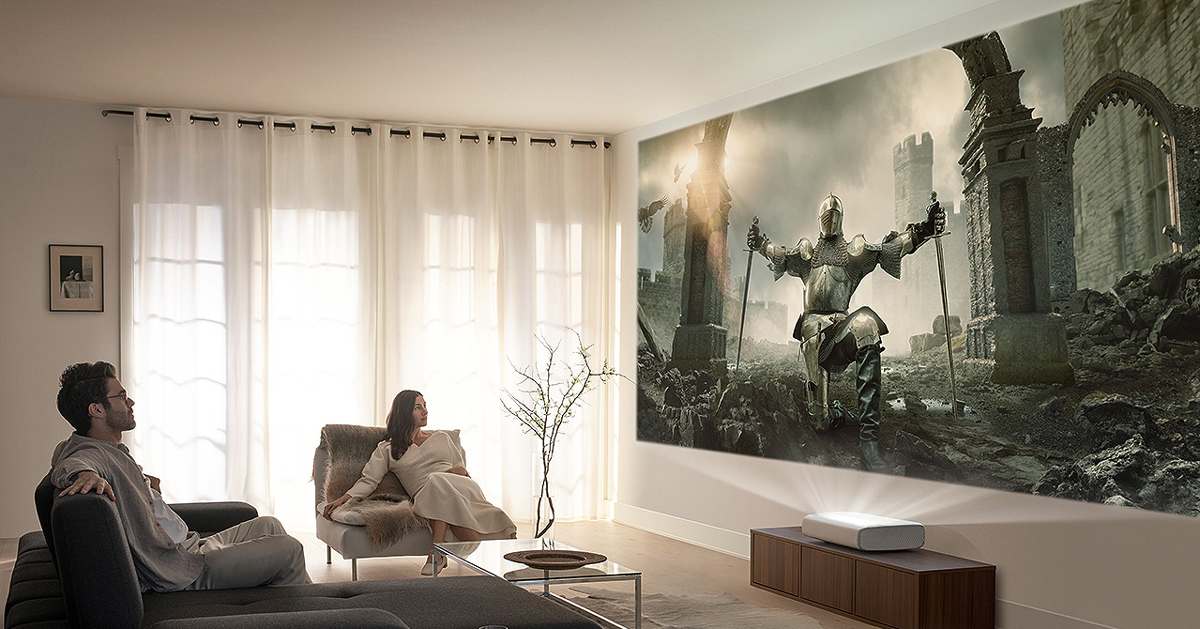Are you looking for a simple way to turn your living room into a movie theater? Look no further!
This complete guide will help you discover the amazing world of projectors for home use and what they have to offer. Let us show you how you can experience the big screen in the comfort of your own home!
Projectors are quickly becoming one of the most popular forms of home entertainment. Whether you’re watching the big game or streaming a blockbuster movie, nothing quite compares to the cinematic experience that modern projectors have to offer. With so many models and features on the market, it can be difficult to know which one is right for your needs. In this complete guide, we will discuss everything you need to know about projectors for home use, from understanding what’s available to choosing the best model for your budget and application.
In this guide you will find information on:
- What options are available when it comes to home projectors
- Key features and technical specifications
- How to choose between a traditional projector and an LED projector
- A detailed comparison of projection technologies
- Determining how much space you need for optimal viewing
- A step by step guide on installation and setup
We hope this guide provides some insight into making an informed decision when selecting a projector for your home theater system.
Explanation of the topic
Home projectors open up a wide world of possibilities for media entertainment. More and more users are making the switch away from TV screens to projectors to experience that full, immersive theater feeling in the comfort and privacy of your own home. Whether it’s for watching movies, gaming or streaming content, owning a projector is an exciting move.
This guide is created to give you an introduction to home projectors in terms of how they work, what features to look out for, what kind of projector best suits your needs and how to set one up in your own home. We have also compiled a comprehensive list of considerations for all budgets as well as some helpful tips for using your projector once you have it up and running.

Benefits of using projectors for home entertainment
Using a projector for home entertainment has many benefits. For one thing, projectors provide much larger images than typical TVs. They also give you more options for where and how big you’d like to watch, providing an immersive experience perfect for movie nights or movie marathons.
Projectors are also typically cheaper than regular televisions, allowing a great bang-for-your-buck value when it comes to setting up home entertainment at a budget in comparison to flat screen high definition televisions.
Finally, higher end models provide enhanced picture quality and resolution compared to some of their traditional counterparts. From crisp 4K Ultra HD visuals to bright whites and deep blacks – you can be sure that any film will look amazing when streamed on one of the top projector models out there.
Considerations when choosing a projector
The key considerations when purchasing a projector for home use include brightness and contrast levels, resolution, available inputs for connecting devices, lamp life and noise output. Despite all this information to take into account, selecting the right projector for your needs does not have to be a complicated task.
When selecting a projector, the first thing you need to consider is the brightness of the picture. Measurements regarding brightness are typically given in lumens – higher lumens ratings mean brighter images. Contrast ratio (measurement of black vs white) is also an important factor in determining image quality; high contrast ratios look more vivid on a projection screen or wall. Achieving great picture quality usually requires both high lumens and good contrast ratio specifications on the projector you choose.
Resolution should also be considered when choosing a projector; resolutions up to 4K Ultra HD are now available on some home theatre models, providing remarkably clear images with stunning detail and vibrant colors suited to movie viewing at home. Additionally, it’s important to think about how you intend to connect all your media sources such as Blu-ray players and digital streaming devices, so ensure that your chosen product features all necessary inputs (HDMI etc).
Lamp life is another essential point; most projectors will feature an LED light which means it isn’t necessary to change the bulb during its lifetime like with older models – saving time and money in maintenance costs. Finally, be sure to look at noise level measurements for quieter operation within your home environment – look out for the term “ dB value” when researching such details of your chosen product model features.
Room size and ambient light
Choosing the right projector requires an assessment of your specific home theater needs, room size and available ambient light. Calculate the size of your desired screen based on the size of the room and whether it will be used in a light-controlled or bright environment. High-lumen projectors are better if you have lots of windows and want to watch during daylight or evening hours where there is more ambient light in your home.
If you are looking for a projector that can produce a large image from close range, look for one with higher lumens and improved contrast ratio. Generally larger projectors are better suited for bigger rooms, while smaller ones can handle smaller spaces where lights cannot be completely dimmed or turned off.

Resolution
A projector’s resolution describes how many distinct pixels it can display, measured in horizontal and vertical lines from left to right and top to bottom, respectively. Horizontal lines are expressed first, followed by vertical lines. For example, if your projector offers a resolution of 1280×800, it is capable of displaying 1280 distinct horizontal pixels from left to right coupled with 800 distinct vertical pixels from top to bottom; in total: 1 024 000 (1M) individual pixels.
Projectors come in 4K UHD (Ultra High Definition) and HD resolutions providing different pixel densities. Choosing the best picture quality for your home setup depends on a variety of factors including the type of content you intend to watch and your budget. Our technology experts have broken down the different types of resolutions available on projectors today:
-SD (Standard Definition): A low-cost analogue technology that supports up to 480×640 (or lower) resolution levels used primarily with older material such as DVDs released before 2006 or VHS tapes.
-720p Resolution: This “HD Ready” digital format supports up to 1280×720 discrete pixel resolution. As the minimum HD resolution accepted by broadcasters today, this format is ideal for movies released prior to 2013 or periodically aired TV shows stored on a computer or scratched DVDs/ Blu Ray discs.
-1080p Resolution : This “Full HD” digital component brings up 1920×1080 discrete pixel resolution for full high definition viewing pleasure. With higher brightness levels than 720p constructions, 1080p ensures better contrast ratios resulting in superior overall picture clarity when projected onto large surfaces that require intense illumination in order for colours to “pop” correctly.
-4K UHD: Ultra High Definition formats marked by 3840×2160 resolve the issue of picture degradation against larger screen sizes while introducing improved sharpness, clarity and colour accuracy made possible through more intricate pixel structures complemented with four times the amount of resolution data available compared to 1080p Full HD offerings.
Contrast ratio
Contrast ratio is all about the difference between darkest and lightest part of your images. The contrast ratio is expressed in either a 1:1 ratio or, more often, as a number within a range—from 1000:1 to up to 20000:1 (sometimes even higher).
Generally speaking, a higher contrast ratio means better quality black levels and brighter whites; on a projector the cinema experience is enhanced with the deeper blacks and bright whites that only high contrast Ratio can offer.
To get good performance from any projector you purchase, look for one with at least an 2000:1 contrast ratio. By paying attention to the contrast ratio of your projector choice, you will ensure that you will get superior color and clarity when viewing your favorite films at home.
Throw distance
Throw distance is the amount of space between the projector and the projection surface you’re projecting onto. It’s measured in a straight line from the front of the projector to the back of the wall or screen. The variances in throw distances make it possible to project photographs, movies and presentations at a variety of sizes.
Fixed lens projectors have one static throw distance so their image size remains consistent unless you purchase a different lens for it. Cables have limits, so make sure to check what type and length your projector requires prior to purchase.
Short-throw projectors have focal lenses that enable them to project larger images from close distances — for example, LCD projectors with a focus range of 5 – 6 feet will give you a clear image on an 8 foot screen. Short-throw models are great for small spaces like home theaters where you don’t want shadows from people passing nearby ruining your image.
Ultra short throw projectors are even more compact than short-throw models since they don’t need much space between the lens and surface per inch of width projected; they can serve as both foreground and background presentation displays in tight spaces such as trade shows and classrooms that only allow limited setup space per presenter/exhibitor. They can also be used in interactive kiosk settings, such as retail displays or self-serve ordering setups, where information must be viewable while also keeping actual contact with equipment/displays (i.e., fingerprint smudges) to an absolute minimum.
Connectivity options
Modern projectors are designed to connect to multiple devices, making it easy to find the right model for your home theater setup. Many projectors come with multiple ports, allowing them to connect simultaneously to Blu-ray players, game consoles, and other A/V components. The most common connection types come in the form of HDMI, VGA and USB inputs.
HDMI is an all-in-one connector offering high quality digital video and sound signal transmission that can be used with compatible devices such as Blu-ray players, gaming consoles and streaming media devices. You can also opt for a projector with a built-in Chromecast technology or direct Wi-Fi access that lets you connect wirelessly from any device whether it’s Mac or PC laptop or smartphone without having to go through a long setup process.
VGA is another popular connection port found on many projectors but is primarily used for analog connections and input from laptops equipped with VGA output. This type of connection generally supports up to 1080p resolution at 60Hz while some models support higher resolutions at 60 frames per second (fps) and above. While it’s great if your laptop has a VGA port, if not you can purchase an inexpensive adapter that will convert the audio/video signal of any device into analog signals beamed directly onto the projector screen either through a cable or wirelessly over Bluetooth or other options.
Finally USB input ports are very versatile as they allow you to plug in different types of USB accessories in addition to mainstream smart devices like mobiles via connecting cables. This makes it easier for people who don’t have compatible connectivity ports on their devices but still want access content from them using their projectors at home.

Conclusion
In conclusion, choosing a projector that meets your needs requires careful consideration of the space available, budget, resolution desired, and other details such as lumens, throw ratio and other features.
If you are looking for a top-of-the-line home projector with all the bells and whistles, then you should expect to pay more for it. However, if your goal is just to upgrade the current home theater setup than occasional multimedia enjoyment then you’ll be able to find a less expensive projector that fits your needs.
In either case, each type of projector offers its own unique advantages and disadvantages. The bottom line is that with proper research and knowledge you can find the perfect projector for your unique set up.
FAQs
What is a good projector for home use?
A good projector for home use will depend on factors such as brightness, resolution, connectivity options, and budget. Look for projectors with high brightness levels and good color accuracy, such as the Epson Home Cinema 2150 or Optoma HD146X.
What is the advantage of screen projector?
The advantages of a screen projector include larger display sizes, more immersive viewing experiences, and more flexibility in placement compared to traditional TVs.
How do projectors work at home?
Projectors work by projecting light onto a screen or wall to create an image. The image is created by shining a light source through an LCD or DLP chip that modulates the light to produce the desired image.
Is a projector worth it at home?
A projector can be worth it at home if you are looking for a larger display size and more immersive viewing experience compared to traditional TVs. However, it may not be the best option for everyone, as projectors can be more expensive and require more setup.
Can projector replace TV?
A projector can replace a TV for some people, but it depends on personal preferences and needs. Projectors offer larger display sizes and more immersive viewing experiences, but they may not be as convenient or easy to use as traditional TVs.
What is the best size for a home projector screen?
The best size for a home projector screen will depend on factors such as room size, viewing distance, and personal preferences. Generally, a screen size between 100-120 inches diagonal is recommended for home theaters.
What are the features of projector?
Features of a projector can include high brightness levels, good color accuracy, high resolution, flexible connectivity options, built-in speakers, and 3D capabilities.
What are the benefits of projector in education?
Projectors can offer several benefits in education, such as larger display sizes, more engaging and immersive presentations, and the ability to share content with a larger audience.
What are the purposes of projector?
Projectors can be used for various purposes, such as home theaters, business presentations, education, gaming, and outdoor events.
Which is best for home TV or projector?
Whether a TV or projector is best for home use will depend on personal preferences and needs. Projectors offer larger display sizes and more immersive viewing experiences, while TVs are often more convenient and easier to use.
See Also:
- Best speakers for projectors
- Best bluetooth projectors
- Best projectors for artists
- Best projectors for bright rooms
- Best projectors for golf simulators

